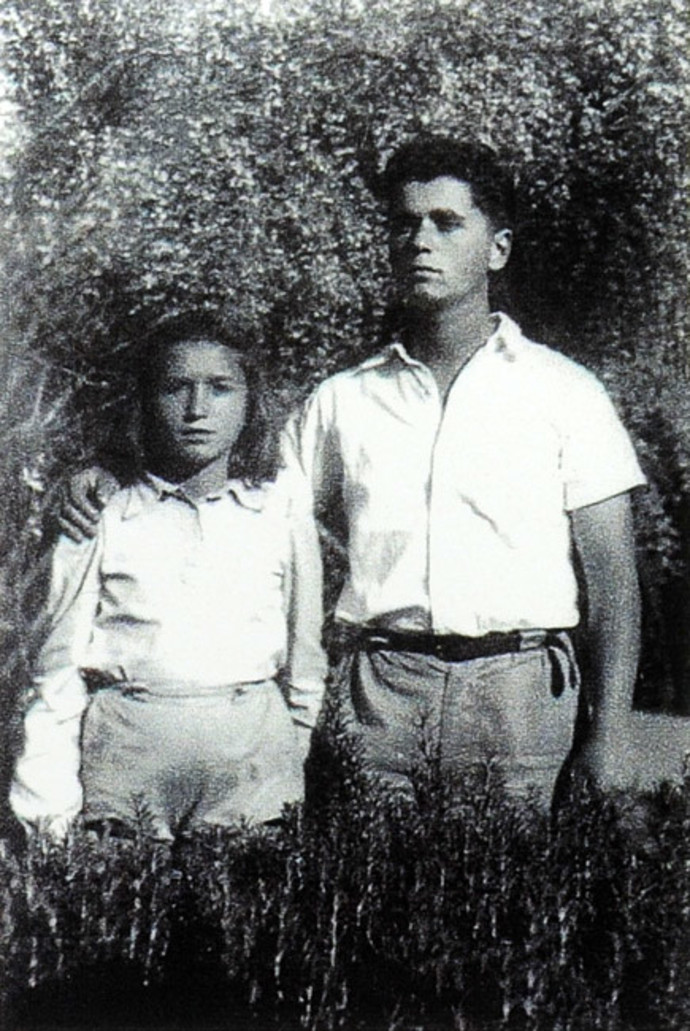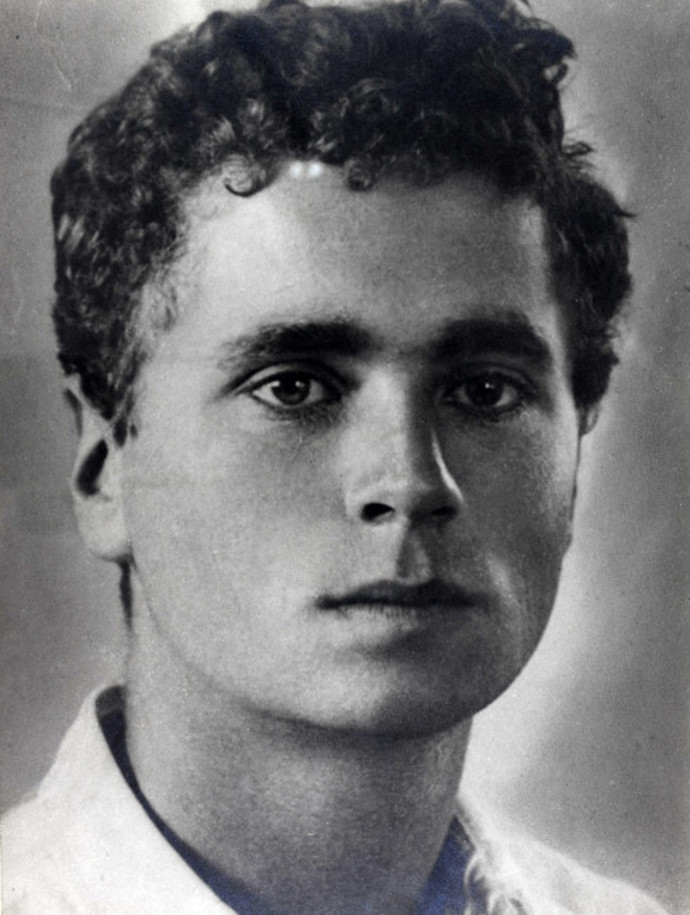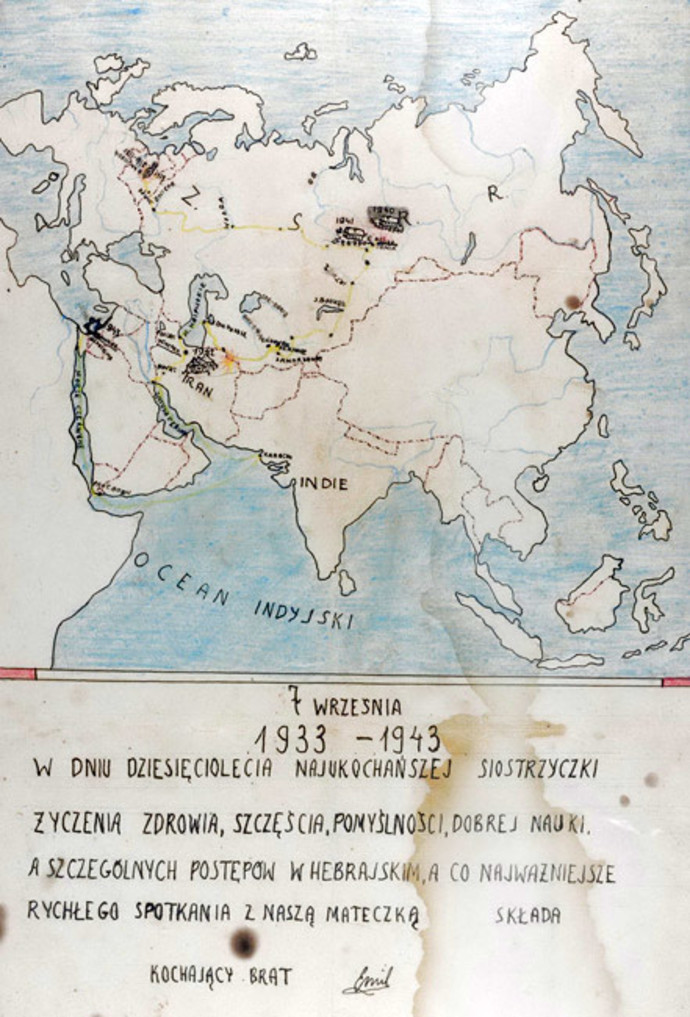In 1939, 1,000 Jewish orphans began a dangerous four-year journey from Poland to pre-state Israel via Iran. Now, in a moving exhibition supported by Jewish National Fund-USA at the Atlit Detention Camp heritage site, a treasure trove of thousands of similar stories are being preserved and retold to a new generation.
Elina Landau had an idyllic childhood. She and her older brother Emil lived with their parents, Mietek, a lawyer, and Fania, an accomplished pianist, in a beautiful home in Warsaw. The family were secular Jews, members of Poland’s upper class, and six-year-old Elina lacked for nothing.
From Warsaw to Siberia
The Landau family’s tranquil life came undone when Nazi Germany reached Warsaw in September 1939. Overnight, the Landaus had to flee for their lives, heading east like many others to escape the approaching Germans. The family eventually reached Soviet-controlled Rivne, and Mietek was conscripted into the Red Army. Fania, Emil, and Elina were packed onto cattle trains and banished to the Asino labor camp in Siberia with other Polish refugees. Conditions were unbearable – and they suffered from constant cold and hunger.

From Siberia to Uzbekistan
In 1941, after Polish citizens in the Soviet Union were granted amnesty, Fania and her children left Asino. They made their way to Samarqand in Uzbekistan, hoping that conditions would improve. For a brief moment, the family was reunited when Mietek was released from the army and sent home. Sadly, he died from typhus just three days later.
Fueled by desperation, Fania felt she had no choice but to give her children to a Christian orphanage to save their lives. Elina recalls that as they were being taught to recite Christian prayers, Emil told her never to forget that she was a Jew.

From Uzbekistan to Tehran
Around that time, the Polish government signed an agreement with the Soviet Union, allowing for the transfer of 24,000 Polish refugees to Iran, which was controlled by Britain at the time. A refugee camp was set up in Tehran, and within that camp, a separate one was created to house orphaned Jewish children. The leaders in Eretz Yisrael - among them Henrietta Szold from Youth Aliyah, and the head of the Aliyah Department who led many dramatic rescue and immigration missions, Eliyahu Dobkin, learned of the existence of this camp. They sent Zipporah Sharett (wife of Moshe Sharrett, who went on to become Israel’s second Prime Minister) to head the Jewish camp, arrange for the children’s care and work to bring them home to pre-State Israel.
Jewish emissaries were also dispatched to find the thousands of Polish Jewish children living in orphanages and even on the streets across the Soviet Union and bring them to the camp in Tehran.
Elina and Emil Landau were among them.
Elina was nine years old when she arrived in Tehran, and the children lived with hundreds of other orphans in the Jewish camp. The emissaries, many of them teenagers themselves, taught them Hebrew and recounted stories about their far-off ancestral soil. Thanks to the generosity of local and international Jewish communities, for the first time in years, Elina and Emil were fed regularly and given structure and routine.
In a letter written by Zipporah Sharett and preserved through the Society for the Preservation of Israel Heritage Sites’ (SPIHS) Atlit Detention Camp archives, she wrote to the Yishuv about the 807 children under her care: “98 children up to the age of 8 sleep in the big room. They sleep on the floor on thin mattresses and pillows filled with cotton wool. The older children sleep in the tents. They have no mattresses or pillows…. the tents are not protected from rain or cold…. I doubt that a quarter of the children have a change of underwear. Two hundred children are barefoot; the rest have shoes that are falling apart. Not one has a warm jersey. “
Finally Home
Elina and Emil spent seven months in Tehran, and they were among the first group of children to leave after they received special immigration visas from the British authorities. Their journey took them through Karachi (then India) and onto the Suez by ship. In 1943, the group reached Israel by train and was taken to Atlit detention camp. They were disinfected, given medical treatment, and divided into smaller groups to be placed in permanent locations around the country.
After four long harrowing years, they now felt like they had come home.
Emil and Elina were sent with their group to Kibbutz Ginegar. Tragically, they learned that their mother Fania had died of starvation in Samarqand before she managed to join them.
Emil and Alina (now Ilana) quickly adapted to life on the kibbutz, and Emil was accepted to the Kaduri agricultural school. He then enlisted in the Palmach (the elite fighting unit of Israel’s pre-state military) and hoped, like many of his age, to serve his people in their struggle for independence.
During his service, Emil wrote numerous letters to Ilana, showering her with love and advice, reminding her of their parents, and even drawing her a map of the treacherous journey made from Warsaw to pre-state Israel for her tenth birthday.

In March of 1948, Emil took part in a dangerous military operation. In the ensuing battle, he was killed in action. He was just 19 years old.
Ilana would go on to accept the Hero of Israel award on her brother’s behalf. Perhaps in a sign of enduring defiance against those who sought her own, and the Jewish people’s destruction, she married and had three beautiful children, in addition to becoming a social worker so she could help struggling children.
Emil and Ilana Landau were just two of nearly 1,000 Jewish children – most orphans– brought from the Soviet Union via Iran to Eretz Yisrael in a saga known as the Tehran Children. Thirty-five of these youngsters fell in battles during Israel’s wars, mainly during the War of Independence in 1948.
“Because of the insistence of the leaders in the Yishuv to bring the children of Tehran home, 1,000 Jews were saved from becoming statistics among the millions who died,” said Vivian Grossman, Jewish National Fund-USA’s VP of Marketing and a member of the organization’s Israel Independence Experience Task Force. “Their poignant story needs to be remembered and told. Imagine that the Atlit Archives, a national treasure, tells thousands of other stories like this! Jewish National Fund-USA and the Society for the Preservation of Israel Heritage Sites (SPIHS) are working hard to develop the Atlit Detention Camp into a first-grade open-air museum so that more visitors from Israel and around the world can come and learn about the incredible stories of people like the Landaus who, despite all odds, came home to Israel.”
For more information about Jewish National Fund-USA’s efforts to preserve Israel’s heritage sites, visit jnf.org/heritage.
